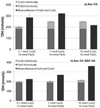Impacts of Antioxidants on Hydroxyl Radical Production from Individual and Mixed Transition Metals in a Surrogate Lung Fluid
- PMID: 22125412
- PMCID: PMC3223868
- DOI: 10.1016/j.atmosenv.2010.12.021
Impacts of Antioxidants on Hydroxyl Radical Production from Individual and Mixed Transition Metals in a Surrogate Lung Fluid
Abstract
Inhalation of ambient particulate matter causes morbidity and mortality in humans. One hypothesized mechanism of toxicity is the particle-induced formation of reactive oxygen species (ROS) - including the highly damaging hydroxyl radical ((·)OH) - followed by inflammation and a variety of diseases. While past studies have found correlations between ROS formation and a variety of metals, there are no quantitative measurements of (·)OH formation from transition metals at concentrations relevant to 24-hour ambient particulate exposure. This research reports specific and quantitative measurements of (·)OH formation from 10 individual transition metals (and several mixtures) in a cell-free surrogate lung fluid (SLF) with four antioxidants: ascorbate, citrate, glutathione, and uric acid. We find that Fe and Cu can produce (·)OH under all antioxidant conditions as long as ascorbate is present and that mixtures of the two metals synergistically increase (·)OH production. Manganese and vanadium can also produce (·)OH under some conditions, but given that their ambient levels are typically very low, these metals are not likely to chemically produce significant levels of (·)OH in the lung fluid. Cobalt, chromium, nickel, zinc, lead, and cadmium do not produce (·)OH under any of our experimental conditions. The antioxidant composition of our SLF significantly affects (·)OH production from Fe and Cu: ascorbate is required for (·)OH formation, citrate increases (·)OH production from Fe, and both citrate and glutathione suppress (·)OH production from Cu. MINTEQ ligand speciation modeling indicates that citrate and glutathione affect (·)OH production by changing metal speciation, altering the reactivity of the metals. In the most realistic SLF (i.e., with all four antioxidants), Fe generates approximately six times more (·)OH than does the equivalent amount of Cu. Since levels of soluble Fe in PM are typically higher than those of Cu, our results suggest that Fe dominates the chemical generation of (·)OH from deposited particles in the lungs.
Figures





References
-
- Aliaga ME, Carrasco-Pozo C, Lopez-Alarcon C, Speisky H. The Cu(I)-glutathione complex: factors affecting its formation and capacity to generate reactive oxygen species. Transition Metal Chemistry. 2010;35:321–329.
-
- Ayres JG, Borm P, Cassee FR, Castranova V, Donaldson K, Ghio A, Harrison RM, Hider R, Kelly F, Kooter IM, Marano F, Maynard RL, Mudway I, Nel A, Sioutas C, Smith S, Baeza-Squiban A, Cho A, Duggan S, Froines J. Evaluating the toxicity of airborne particulate matter and nanoparticles by measuring oxidative stress potential - a workshop report and consensus statement. Inhalation Toxicology. 2008;20:75–99. - PubMed
-
- Brunekreef B, Holgate ST. Air pollution and health. Lancet. 2002;360:1233–1242. - PubMed
-
- Buxton GV, Greenstock CL, Helman WP, Ross AB. Critical review of rate constants for reactions of hydrated electrons, hydrogen atoms and hydroxyl radicals (OH/O-) in aqueous solution. Journal of Physical and Chemical Reference Data. 1988;17:513–886.
-
- Carter JD, Ghio AJ, Samet JM, Devlin RB. Cytokine production by human airway epithelial cells after exposure to an air pollution particle is metal-dependent. Toxicology and Applied Pharmacology. 1997;146:180–188. - PubMed
Grants and funding
LinkOut - more resources
Full Text Sources
Miscellaneous
